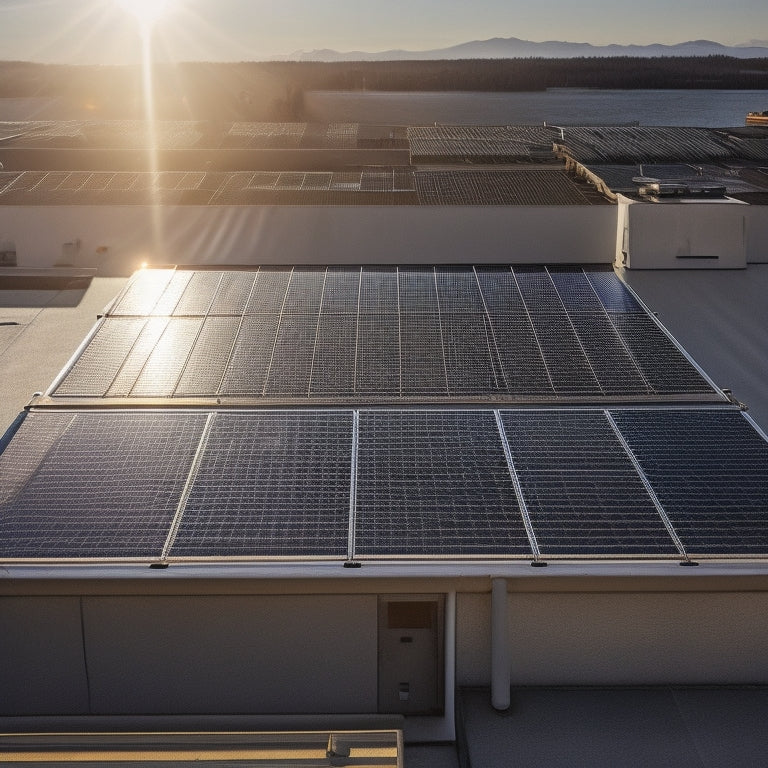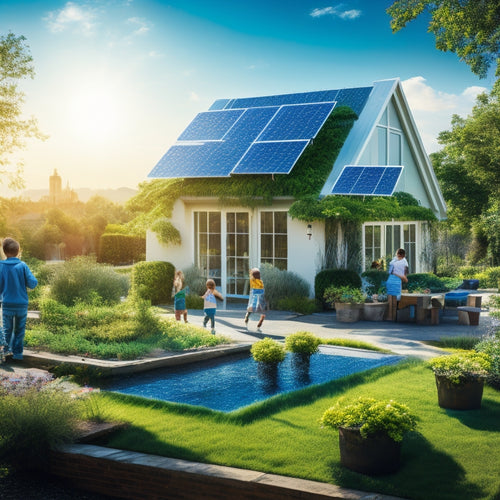
Are Commercial Photovoltaic Panels a Cost-Effective Option
Share
You can generate a significant return on investment with commercial photovoltaic panels, which typically pay for themselves within 5-7 years through reduced energy bills and government incentives. By utilizing renewable energy, you'll enjoy energy independence, lower operating costs, and a reduced carbon footprint. While initial installation costs vary, financing options and tax credits can mitigate upfront expenses. As you weigh the benefits, consider the importance of evaluating energy efficiency, performance, and maintenance requirements. By crunching the numbers and examining the payback period, you'll get a clearer image of the cost-effectiveness of commercial photovoltaic panels, and what it means for your bottom line going forward.
Key Takeaways
- Commercial photovoltaic panels provide long-term savings, reducing operating costs and energy bills, with average installation costs ranging from $50,000 to $200,000.
- Financing options, including tax credits and rebates, can significantly reduce upfront investment costs, making commercial photovoltaic panels a cost-effective option.
- Energy independence and reduced reliance on the grid lead to lower operating costs, fixed energy costs, and a lower carbon footprint.
- High-efficiency panels with advanced technologies like bifacial cells enhance energy capture, ensuring faster returns on investment and increased profitability.
- With a lifespan of 30 years or more, commercial photovoltaic panels require minimal maintenance and repairs, further increasing their cost-effectiveness.
What Are Commercial Photovoltaic Panels
Commercial photovoltaic panels convert sunlight into electrical energy, offering a clean and sustainable solution for businesses to power their operations. You're likely familiar with the concept, but let's explore deeper into the technology behind these panels.
Commercial photovoltaic panels employ photovoltaic technology, which involves the conversion of sunlight into electrical energy through an array of photovoltaic cells. These cells are made from semiconducting materials like silicon, which release electrons when exposed to sunlight.
The efficiency of these panels is critical, as it directly impacts the amount of energy generated. Panel efficiency is measured by the percentage of sunlight converted into electrical energy. High-efficiency panels can achieve efficiencies of up to 22%, while standard panels typically range from 15% to 18%.
When selecting commercial photovoltaic panels, you'll want to take into account factors like panel efficiency, durability, and warranty to guarantee you're getting the most out of your investment.
Benefits of Renewable Energy Sources
You'll find that investing in renewable energy sources like commercial photovoltaic panels offers several key benefits.
For one, you'll gain energy independence, freeing yourself from reliance on the grid.
Additionally, you'll reduce your carbon footprint and lower your operating costs, making your business more sustainable and profitable.
Energy Independence Now
As the world grapples with the challenges of climate change, energy security, and economic uncertainty, renewable energy sources are emerging as a guiding light of hope for a sustainable future.
You're likely aware that relying on fossil fuels is no longer a viable option. By utilizing the power of the sun, you can take control of your energy needs, reducing your reliance on the grid and enjoying energy autonomy.
Commercial photovoltaic panels offer you solar independence, allowing you to generate clean energy on-site. This means you're no longer at the mercy of fluctuating energy prices or supply chain disruptions.
With solar panels, you can lock in a fixed energy cost, providing a sense of security and stability in an uncertain world. Furthermore, you'll be reducing your reliance on non-renewable energy sources, contributing to a cleaner, healthier environment.
Reduce Carbon Footprint
Break free from the shackles of carbon-intensive energy sources and tap into the boundless potential of renewable energy. By utilizing the power of photovoltaic panels, you're not only reducing your reliance on fossil fuels but also greatly decreasing your carbon footprint.
This shift towards sustainability practices is vital in today's environmentally conscious environment.
As a business owner, you're likely aware of the importance of adhering to environmental policies and regulations. By investing in commercial photovoltaic panels, you're proactively reducing your organization's impact on the environment.
The clean energy generated by these panels doesn't produce any greenhouse gas emissions, making it an attractive option for companies looking to minimize their ecological footprint.
Lower Operating Costs
Solar panels installed on rooftops or in sprawling fields generate electricity without incurring fuel costs, a stark contrast to traditional power plants that burn fossil fuels. This fundamental difference in energy production translates to considerable operational savings for you. With commercial photovoltaic panels, you can expect to reduce your energy expenditures considerably.
| Energy Source | Fuel Costs | Energy Reliability |
|---|---|---|
| Fossil Fuels | High | Unreliable (subject to price volatility) |
| Nuclear Energy | Low | High (stable output) |
| Solar Energy | Zero | High (predictable output) |
| Wind Energy | Zero | Medium (weather-dependent output) |
Initial Investment and Installation Costs
Within the domain of commercial photovoltaic (PV) panel installations, the initial investment and installation costs are a critical factor for businesses and organizations looking to harness the power of renewable energy.
You'll need to evaluate the upfront costs of purchasing and installing the PV system, including the panels, inverters, mounting hardware, and installation labor.
The total cost of a commercial PV installation can vary widely, depending on factors such as system size, installation complexity, and local labor costs. On average, the cost of a commercial PV installation ranges from $2.50 to $3.50 per watt, with larger systems typically costing less per watt than smaller ones.
For a typical commercial installation, you can expect to pay between $50,000 and $200,000 or more, depending on the size of the system.
Fortunately, there are financing options and tax credits available to help offset these costs. You may be eligible for federal and state tax credits, which can provide a significant reduction in your upfront investment.
Additionally, many financing options are available, including power purchase agreements, leases, and loans, which can help spread the cost of the system over time.
Long-Term Savings and Incentives
As you traverse the financial aspects of commercial photovoltaic panel installations, it's essential to evaluate the long-term savings and incentives that can greatly offset the initial investment.
One major advantage is the reduction in your electricity bills, which can lead to substantial savings over time. Additionally, many governments offer incentives, such as tax credits or rebates, to encourage businesses to adopt renewable energy sources. These government incentives can greatly reduce the upfront cost of installation.
You'll also find various financing options available, including power purchase agreements (PPAs) and solar leases, which can help spread the cost over several years.
With PPAs, for instance, you'll pay a fixed rate for the electricity generated, while the installer handles maintenance and upkeep. Solar leases, on the other hand, allow you to rent the system for a set period, often with little to no upfront cost.
Energy Efficiency and Performance
Commercial photovoltaic panels are designed to optimize energy efficiency and performance, guaranteeing you get the most out of your investment.
When evaluating the energy efficiency of these panels, you'll want to take into account performance metrics such as the power output, efficiency rating, and temperature coefficient. A higher power output translates to more electricity generated per unit area, while a higher efficiency rating indicates a greater percentage of sunlight is converted into usable energy. The temperature coefficient, meanwhile, affects the panel's performance in high-temperature conditions.
To maximize energy efficiency, commercial photovoltaic panels often employ advanced technologies like bifacial cells, which capture light from both the front and back sides of the panel.
Additionally, some panels feature built-in inverters that optimize energy conversion at the individual panel level. By selecting panels with high energy efficiency and performance metrics, you can secure a faster return on investment and greater long-term savings.
When evaluating the energy efficiency and performance of commercial photovoltaic panels, it's crucial to take these factors into account to get the best possible results from your installation.
Maintenance and Repair Requirements
The lifespan of commercial photovoltaic panels can span several decades, making maintenance and repair an important aspect of their overall performance. As you invest in these panels, you'll need to take into account the maintenance and repair requirements to guarantee peak energy output.
Regular cleaning is vital to prevent dirt and debris from affecting panel efficiency. You'll need to schedule annual or bi-annual cleaning, depending on your location and environmental conditions.
In terms of repair frequency, commercial photovoltaic panels are designed to be durable and require minimal repairs. However, you should budget for occasional repairs or replacements of faulty components.
The panel lifespan and repair frequency are closely linked, as well-maintained panels will require fewer repairs and last longer. A typical commercial photovoltaic panel can last up to 30 years or more, with some manufacturers offering warranties of up to 25 years or more.
Commercial Property Value Increase
Your investment in commercial photovoltaic panels not only generates clean energy but also enhances your property's worth. A property appraisal will likely reflect the increased worth, as the installation of solar panels is considered a significant asset. This is because they reduce energy costs, attract tenants who appreciate sustainability, and increase the property's appeal to environmentally conscious buyers.
As market demand for eco-friendly properties continues to grow, your commercial property becomes more attractive to potential buyers and renters. This increased demand translates to higher property worths and potentially higher rental income.
In fact, studies have shown that properties with solar panels sell for a premium compared to those without. By installing commercial photovoltaic panels, you're not only reducing your carbon footprint but also making a smart business investment.
With the added worth, you can increase your property's marketability, attract high-quality tenants, and reap the financial benefits of your investment.
Return on Investment Analysis
You'll want to calculate the payback period to determine how long it takes for the photovoltaic panel system to pay for itself through energy savings.
This analysis will provide a clear understanding of when you can expect to break even on your investment.
Additionally, you should consider the net present value (NPV) of the system, which takes into account the time value of money and provides a more thorough view of the investment's profitability.
Payback Period Analysis
Calculating the payback period of a commercial photovoltaic panel investment is crucial in determining its viability, as it directly impacts your business's bottom line. This metric measures the time it takes for your investment to generate sufficient returns to cover its initial cost. A shorter payback period indicates a more attractive investment opportunity.
To calculate the payback period, you'll need to take into account various factors, including the upfront cost of the system, financing options, and projected annual energy savings. Economic trends, such as fluctuating energy prices, can also influence the payback period. By analyzing these factors, you can estimate the number of years it'll take for your business to break even on its investment.
A thorough payback period analysis helps you make informed decisions about your commercial photovoltaic panel investment. It enables you to compare different financing options, assess the impact of various economic trends, and prioritize investments that offer the shortest payback periods.
Net Present Value
Beyond payback period analysis, a more extensive approach to evaluating commercial photovoltaic panel investments involves examining their net present value (NPV). This financial modeling technique calculates the present value of future cash flows, providing a more thorough understanding of your investment's potential returns. By considering the time value of money, NPV analysis helps you determine whether your commercial photovoltaic panel investment will generate a positive return on investment.
To calculate NPV, you'll need to estimate the cash inflows and outflows associated with your investment, including installation costs, maintenance expenses, and revenue generated from electricity sales. You'll also need to choose a discount rate, which represents the rate of return you could earn from a similar investment.
Here's an example of how NPV analysis might look for a commercial photovoltaic panel investment:
| Year | Cash Flow | Discounted Cash Flow |
|---|---|---|
| 0 | -$100,000 | -$100,000 |
| 1 | $20,000 | $18,181 |
| 2 | $20,000 | $16,529 |
| 3 | $20,000 | $14,949 |
| 4 | $20,000 | $13,423 |
Frequently Asked Questions
Can Commercial Photovoltaic Panels Be Installed on Older Buildings?
You'll face unique installation challenges when putting commercial photovoltaic panels on older buildings, requiring thorough structural assessments to guarantee the roof can support the added weight and stress of the panels and mounting system.
Do Photovoltaic Panels Require Special Insurance Coverage?
As you shield your business from financial storms, you'll find photovoltaic panels require special insurance coverage, symbolizing a safeguard for your investment. You'll need to steer through insurance requirements, evaluating coverage options, to guarantee your renewable energy assets are protected from unexpected events.
Can I Install Commercial Panels Myself to Save Money?
You can attempt a DIY installation to save money, but you'll still need installation permits, which may negate your cost savings, and improper installation can void warranties and compromise system performance.
Are There Any Tax Implications for Selling Excess Energy?
You'll be interested to know that the US solar market grew 43% in 2020 alone! When selling excess energy, you'll benefit from net metering, earning energy credits that offset your utility bills, and potentially generating a profit, depending on local policies and tax incentives.
Can I Use Commercial Panels for Both Electricity and Heating?
You can utilize commercial panels for dual use systems, generating both electricity and heat, enhancing energy efficiency. By integrating a heat exchanger, you'll maximize your system's output, increasing your energy independence and reducing reliance on traditional heating sources.
Conclusion
As you weigh the pros and cons of commercial photovoltaic panels, the verdict is clear: they're a shining star in the renewable energy firmament. While upfront costs may seem intimidating, long-term savings and incentives will have your business basking in the warmth of profitability. With energy efficiency and performance that's off the charts, and maintenance requirements that are a breeze, the ROI will have you beaming with satisfaction. It's time to capture the power of the sun and let your bottom line soar.
Related Posts
-

Solar Energy Benefits for Sustainable Living
Solar energy provides numerous benefits for sustainable living that you can't overlook. By switching to solar, you'll...
-

Energy-Efficient Home Upgrades for Cost Reduction
To reduce costs with energy-efficient home upgrades, focus on essential improvements like smart thermostats, energy-e...
-

Solar Inverter Troubleshooting for Beginners
Troubleshooting your solar inverter starts with understanding its efficiency and performance metrics. Check for prope...


